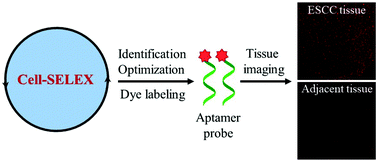Evolution of DNA aptamers against esophageal squamous cell carcinoma using cell-SELEX†
Abstract
Esophageal cancer is the ninth most common cancer and the sixth most common cause of cancer-related death worldwide, and the esophageal squamous cell carcinoma (ESCC) subtype accounts for about 90% of all cases of esophageal cancer globally. Currently, ESCC is usually diagnosed in late stages, and targeted therapy is lacking. Therefore, the development of ESCC-specific recognition molecules for an early detection and targeted treatment of ESCC is urgently needed. Aptamers are an excellent molecular recognition tool with unique advantages. In this manuscript, three aptamers (S2, S3, and S8) specific to ESCC cells were successfully screened via cell-SELEX. The experimental results displayed the high affinities of the three aptamers for target KYSE150 cells with dissociation constants in the nanomolar range. The specificity evaluation showed that S2 only bound target KYSE150 cells, but S3 and S8 were capable of targeting a series of ESCC cells. Moreover, several truncated aptamers were generated through sequence optimization. In particular, an ultrashort aptamer S3–2–3 with only 18 bases was successfully obtained; after labeling with Cy5 dyes, it was feasible for the specific imaging of ESCC tissues. Furthermore, the target types of the selected aptamers were preliminarily identified as membrane proteins, and target proteins could be captured by S3–2–3, which may be useful for biomarker discovery. Therefore, the selected aptamers hold great potential for clinical diagnosis, biomarker discovery, and the targeted therapy of ESCC.

- This article is part of the themed collection: Analyst Recent HOT articles


 Please wait while we load your content...
Please wait while we load your content...